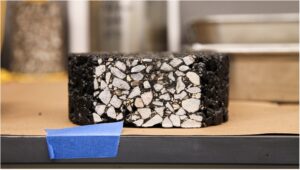Recycled Materials Make Asphalt More Durable
Vanguard paving project on Missouri’s I-155 assessing nine different types of recycled materials in real-world test
Asphalt pavement, used to construct millions of roads across the United States, deteriorates over time. To fix America’ s collapsing road system, investigators at the University of Missouri are now using recyclables, including plastic waste.
In partnership with MoDOT, University of Missouri researchers recently created a real-world test road using recycled materials along a portion of Interstate 155 in the Missouri Bootheel.
Investigators from the Mizzou Asphalt Pavement and Innovation Lab (MAPIL) designed a real-world test road using recycled materials such as scrap tire rubber and plastic waste along a portion of Interstate 155 in the Missouri Bootheel in collaboration with the Missouri Department of Transportation (MoDOT).
According to Bill Buttlar, Director of MAPIL, this innovative process can reduce the number of items ending up in landfills or leaking into the environment by enhancing the sustainability of asphalt mixes.
“Missouri is the Show-Me State, so we take a very pragmatic view. The science can be thorny and difficult, but we are up to the task. We’re excited that while our approach is complicated in the lab, its simple to execute in the field, so it makes it easily adaptable, scalable, and cost-effective to incorporate into many types of road environments, “ Buttlar said
The I-155 project expands on the group’s previous test road, installed along a stretch of Stadium Boulevard in Columbia, Missouri. Instead of testing only four different types of recycled materials, the I-155 project will assess the real-world effectiveness of nine different types of recycled materials in the production of asphalt pavement.
This includes three types of polyethylene (PE) ;a material frequently seen in plastic grocery bags ;as well as ground tire rubber.
 “These projects afford us an opportunity to intentionally build the next generation of roads with these materials not as a type of linear landfill, but to also help the environment while making the value of dollars spent on transportation infrastructure like this stretch farther into the future,” Buttlar, who also serves as he Glen Barton Chair in Flexible Pavements, said.
“These projects afford us an opportunity to intentionally build the next generation of roads with these materials not as a type of linear landfill, but to also help the environment while making the value of dollars spent on transportation infrastructure like this stretch farther into the future,” Buttlar, who also serves as he Glen Barton Chair in Flexible Pavements, said.
MAPIL’s research group has resolved most of the translational research questions, such as durability and safety, that could dissuade a general contractor or department of transportation from adopting this ground-breaking strategy, placing MU at the forefront of this type of work in the United States, Buttlar said.
“We don’t just live in the laboratory. In the field of transportation material research, we need to see how all the various materials used to construct a road — the rock, the asphalt, and the recycled materials– behave in the real world and gel together to build a road,” Buttlar said.
“Asphalt is liquified with heat, and when you put an additive in like a plastic or rubber material, you must get everything to bond together with good adhesion. But we’re only going to know if that happens successfully when we produce it on a full-scale level and then expose it to elements, such as different weather conditions and heavy traffic, he said.”
MAPIL specializes in a dry process, which allows scientists to easily incorporate recyclables into the mixture prior to application to a road surface. The form, shape, and size of the plastics bring different challenges in how the material flows, how it behaves and how it mixes. MAPIL Researchers extensive small-scale testing for almost an entire year before moving to a larger scale out in the field with contractors, Punya Rath, an Assistant Research Professor in the Department of Civil and Environmental Engineering said.
The investigators can assess the mixtures in the field with the help of a mobile research lab, which they established and used for both the Stadium Boulevard and I-155 projects.
It helps the Missouri Department of Transportation (MoDOT) immensely to have a mobile research lab on-site in the field that has the ability to rapidly test samples and provide results within 24-48 hours to better inform the process, Rath said.
Buttlar, citing environmental concerns, stated that the team ensures that everything they do is within the prevailing limits of the Environmental Protection Agency (EPA).
”We are designing the material to be able to hold or capture the environmental by-products at the highest percentage for the longest amount of time. It’s not going to be a 100 percent containment. Everything built in a natural environment will degrade over time, so that’s why EPA has standards for everything, and we make sure we are safely within those standards, “ Buttlar said.
Source: https://missouri.edu/
© Scrap Tire News, August 2023






